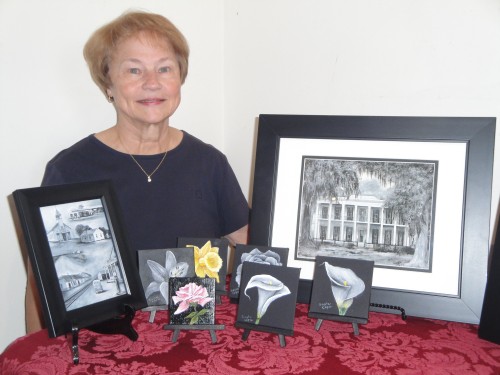Recipe: Turkey Pâté en croûte
November 1, 2012
Editor’s Picks for November
November 1, 2012To take a trip back in time to Schriever, visit Southdown Plantation House to view artist Gayle Cope’s retrospective of that community.
Although some floral works are interspersed in Cope’s exhibit, her work predominantly focuses on the buildings and houses that defined the Schriever community when it was a busy, thriving railroad stop. Polmer’s general store, Ducros Plantation, the original St. Bridget Catholic Church, the Texaco station and St. Mark’s Church before renovations are some of the images Cope has rendered in acrylic paint.
“I have so much interest in the Schriever resettlement project from 1939 to 1944,” a New Deal program that created a government sugar cane farm and 73 homesteads on four acres each and aimed at promoting farming and build the economy, she said. The government interviewed people to become part of the farming community, which spanned from Highway 311 to Julia Road (commonly called the Thibodaux bypass).
Her parents, Sophie and Henry Blanchard, relocated from Bourg as part of that project and later purchased their homestead which included the house, a barn, chicken house, and an outhouse on 100 areas. That’s where Cope and her siblings grew up; her home is located on what used to be her father’s cornfield.
Cope’s keen interest in Schriever and the resettlement project is the source of inspiration for her paintings which will serve as illustrations for the book she’s writing on the subject. Expected to be self-published in about a year, Cope has been interviewing Schriever residents and spent three and a half years painting 25 buildings from the community. Since many of the structures are no longer standing, she often works from photographs of the plantation tenant houses, government-built houses or old schools.
Although mostly self-taught, it was at the urging of one of Cope’s art teachers, Billy Ledet of Thibodaux, that she explored painting the Schriever landmarks in black and white. Only a couple of the buildings, like Schriever Elementary at which Cope taught first grade for 25 years, are rendered in color.
“It amazes me that you can get so much out of black and white,” Cope said, “so many variations with just two colors.” Using such a limited palette helped her to evoke a feeling of a bygone era in the paintings.
“I just get such pleasure of that white, blank canvas then I just start putting paint (and) your picture comes alive. That’s what thrills me,” she said, along with seeing people’s reactions and causing them to reminisce when viewing the old Schriever landmarks.
While she’s finished the Schriever series of paintings and will be focusing on finishing her book on the resettlement project, that doesn’t mean Cope is going to put down her brushes.
“I think I may start on Thibodaux next,” she said. In fact, Cope has already painted the old Grand Theater which used to stand on Green Street in Thibodaux. It is hanging in her Southdown exhibit, which can be viewed 10 a.m. to 4 p.m. Tuesday through Saturday until Nov. 16; exhibit admission is $2.
Gayle Cope stands behind images from her “Schriever Scenes from the Past” series, which revisits the area when it was a thriving railroad stop. The series is on display at Southdown Plantation House in Houma through Nov. 16.







